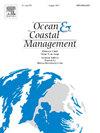Quantifying the contribution of ship emissions to black carbon pollution along the coast of the East China sea using machine learning approach
IF 4.8
2区 环境科学与生态学
Q1 OCEANOGRAPHY
引用次数: 0
Abstract
Ship emissions are a significant source of atmospheric black carbon (BC) aerosols, impacting both human health and climate, particularly in nearshore marine environments. However, the influence of ship activity on BC pollution and its extent remains poorly constrained. In this study, we quantified the contribution of ship emissions to BC pollution along the East China Sea coast near the Ningbo-Zhoushan harbor during the fishing season. This was achieved using an Extreme Gradient Boosting (XGBoost) model combined with ship activity data obtained from Automatic Identification System (AIS) signals. Our findings reveal that ship speed and ship count are critical factors influencing BC mass variability, alongside seasonal changes in emission intensity (reflected by Unix time) and meteorological factors. Increased ship speeds, particularly for fishing vessels (over 6 knots), and higher ship counts were generally associated with elevated BC mass concentrations. By training the XGBoost model on data from non-ship periods, we effectively separated BC contributions from ship emissions during the entire observation period. Ship emissions were found to contribute 10 %–60 % of the total BC mass, exhibiting a characteristic diurnal pattern with higher contributions in the morning and evening rush hour, corresponding to ship departures and returns at the port. These results underline the potential of machine learning approaches for evaluating ship emissions and highlight the significant role of ship activity in BC pollution in the nearshore environments of the East China Sea.
利用机器学习方法量化东海沿岸船舶排放对黑碳污染的贡献
船舶排放是大气中黑碳(BC)气溶胶的一个重要来源,影响人类健康和气候,特别是近岸海洋环境。然而,船舶活动对不列颠哥伦比亚省污染的影响及其程度仍然缺乏限制。在本研究中,我们量化了渔船排放对宁波-舟山港附近东海沿岸BC污染的贡献。这是通过极端梯度增强(XGBoost)模型结合从自动识别系统(AIS)信号获得的船舶活动数据实现的。我们的研究结果表明,除了排放强度的季节变化(由Unix时间反映)和气象因素外,船速和船舶数量是影响BC质量变化的关键因素。船速的增加,特别是渔船(超过6节),以及船只数量的增加通常与BC质量浓度的升高有关。通过对非船舶时期的数据进行XGBoost模型的训练,我们有效地将整个观测期间的BC贡献与船舶排放分离开来。研究发现,船舶排放占总BC质量的10% - 60%,呈现出一种特征的日模式,早晚高峰时段的贡献更高,对应于船舶在港口的出发和返回。这些结果强调了机器学习方法在评估船舶排放方面的潜力,并强调了船舶活动在东中国海近岸环境中BC污染中的重要作用。
本文章由计算机程序翻译,如有差异,请以英文原文为准。
求助全文
约1分钟内获得全文
求助全文
来源期刊

Ocean & Coastal Management
环境科学-海洋学
CiteScore
8.50
自引率
15.20%
发文量
321
审稿时长
60 days
期刊介绍:
Ocean & Coastal Management is the leading international journal dedicated to the study of all aspects of ocean and coastal management from the global to local levels.
We publish rigorously peer-reviewed manuscripts from all disciplines, and inter-/trans-disciplinary and co-designed research, but all submissions must make clear the relevance to management and/or governance issues relevant to the sustainable development and conservation of oceans and coasts.
Comparative studies (from sub-national to trans-national cases, and other management / policy arenas) are encouraged, as are studies that critically assess current management practices and governance approaches. Submissions involving robust analysis, development of theory, and improvement of management practice are especially welcome.
 求助内容:
求助内容: 应助结果提醒方式:
应助结果提醒方式:


